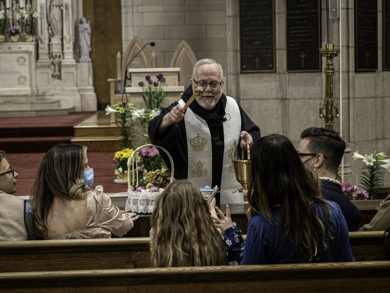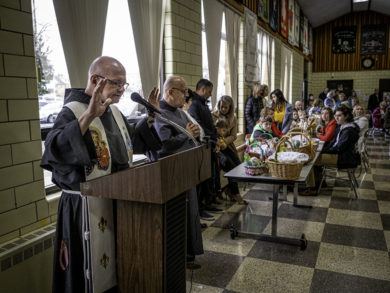April 16, 2022
Local parishes carry on Holy Saturday tradition of blessing Easter food
REGIONAL
By Rebecca Drake

Conventual Franciscan Father Albert Scherer, pastor of Our Lady of the Cross Parish in Holyoke, blesses parishioners’ Easter baskets during the annual blessing of East food on Holy Saturday, April 16. (iObserve photo/Fred LeBlanc)
Father in heaven, let your blessing come upon these eggs. When we break them, we see a sign of your Son rising to new life from the tomb. May we eat them in joyful celebration of his resurrection, for he lives and reigns with you for ever and ever. Amen
–From “Blessing of Food at Easter”
SPRINGFIELD – Conventual Franciscan Father Brad Milunski remembers participating in the Eastern European Catholic tradition of Blessing of Food at Easter at his home parish, St. Stanislaus, in Amsterdam, N.Y.
Now, as pastor of St. Stanislaus Bishop and Martyr Basilica Parish in Chicopee, he is inspired by the parishioners who carry on this tradition that, he says, is about much more than food.
“The tradition is about the thanksgiving (for) and blessings of God’s abundance after the fasting and penitence of Lent,” he said.
He noted the efforts parishioners put into decorating their baskets of Easter food and drink, saying, “It’s not just the food itself, it’s the decorations surrounding it. It really expresses the joy of getting together and a sense of hospitality and trying to bring the family together.”
In the Polish tradition, the food in the baskets includes colored and decorated eggs, butter or bread molded into the shape of a lamb, Easter bread, kielbasa (sausage), candy, fruits, pastries, and wine, all of which are symbolic of Christ’s Resurrection and God’s generosity.
Baskets can also include dried flowers or other greenery, symbolic of spring and new life; and white candles, signifying Christ as the light of the world.

Conventual Franciscan Father Brad Milunski, pastor of St. Stanislaus Bishop and Martyr Basilica Parish in Chicopee, begins the liturgy of the Blessing of Food at Easter, held in the St. Stanislaus School cafeteria on April 16. (iObserve photo/Fred LeBlanc)
The baskets also sometimes contain a bottle of holy water; and beautiful embroidered linens, symbolic of Christ’s burial shroud, envelop all of the items.
“The food becomes a work of art, surrounded by beauty, surrounded by art,” said Father Milunski.
The blessing of the Easter food is done during a brief liturgy in a church or parish hall. Baskets are lined up on tables or at the altar or carried by parishioners to be blessed by the priest. The liturgy includes blessings for each type of food and concludes with the priest’s blessing of the worshippers.
At local parishes, including St. Stanislaus Basilica and Our Lady of the Cross Parish in Holyoke, the blessing of Easter food is done in three separate time slots. Conventual Franciscan Father Albert Scherer, pastor of Our Lady of the Cross, estimates that a total of more than 100 people participate in the blessing of food during the 11 a.m., noon, and 1 p.m. sessions.
Father Scherer, who is not of Polish descent, said he was introduced to the tradition of Easter food blessing when he became a Franciscan and noted that parishioners of various ethnic backgrounds participate in the blessing at Our Lady of the Cross, parish formed when the city’s former Irish parish, Holy Cross, merged with its former Polish parish, Mater Dolorosa, in 2011.
Father Scherer said he is especially inspired by the Polish American parishioners who are dedicated to the special Easter blessing.

(iObserve photo/Fred LeBlanc)
“It’s what they were brought up with,” he said. “I like being part of it. It’s heartwarming that people want to continue it each year.”
Father Milunski, who has cousins living in Poland, said that even for everyday meals, his Polish relatives use decorated tablecloths and napkins. “It’s almost like a liturgical ritual, how it’s presented and how it’s served,” he said. “It’s that deep sense of tradition.”
And the blessing of the Easter food in particular, he said, is a reminder “that everything we do is dedicated to God – even our food – and it has to be something beautiful, something colorful, expressing the joy of Easter.”
“It is a really beautiful tradition,” Father Milunski said. “It’s not just church. This is something outside of the liturgy schedule. People bring their food to church and (then) they’re actually bringing the liturgy back to the house.”


 Facebook
Facebook Youtube
Youtube
